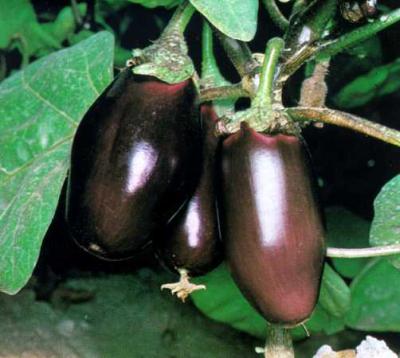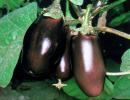
|
Eggplant
Scientific name:
Solanum melongena
Order/Family:
Solanales: Solanaceae
Local names:
Aubergine, Brinjal, Birigiyani (Swahili)
Pests and Diseases:
Anthracnose
Aphids
Bacterial wilt
Budworm
Cotton leafhoppers or jassids
Cutworms
Early blight
Eggplant lace bug
Epilachna beetles
Fusarium wilt
Late blight
Mole crickets
Phytothphora fruit rot
Powdery mildew
Root-knot nematodes
Shoot and fruit borer
Spider mites
Thrips
Weeds
Whiteflies
|
Anthracnose (Colletotrichum melongenae)
Spots of fruits are sunken. When weather is moist, the spots get tan-coloured (growth of fungal spores). There may be several spots on affected fruit and they may join up and cover the whole fruit. Severely affected fruits drop. Eventually, affected fruits dry and become black. Most often, soft-rot bacteria invade affected fruits and cause a soft watery decay. The fungus usually attacks fruits on plants that are weakened or over-ripe. Infection is favoured by relative humidity close to 100% and temperatures between 21 and 30° C.
- Use resistant varieties, if available.
- Use certified disease-free seeds.
- Practise crop rotation.
- Destroy infected crop residues.
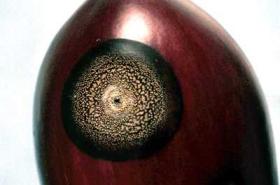
© Anna L. Snowdon. Reproduced from the Crop Protection Compendium. CAB International, Wallingford, UK, 2004.
Aphids (Aphis gossypii)
Aphids are found in groups on the under surface of young leaves. When numbers increase they can move to upper leaf surfaces, stems and flowers. Aphids, in particular the cotton aphid, can become important pests in the cool dry season.
- Spray neem products. They have a repellent effect and have been effective in reducing numbers of the cotton aphid on eggplants. Effective treatments included foliar sprays with aqueous extracts of neem seeds, kernel and neem cake at concentrations of 10 to 50 g/l, and 3% neem oil applied at 10 days intervals. Bare root dipping with 50g/l aqueous neem kernel seed extract, 3% neem oil and a 10 g/l aqueous neem cake extract have also been effective (Ostermann & Dreyer,1995).
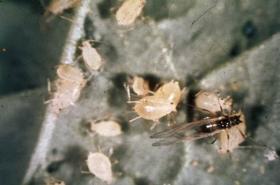
© Mississippi State University Archive, Mississippi State University, Bugwood.org
Bacterial wilt (Ralstonia solanacearum)
This disease occurs with bad drainage, especially in the hot, wet season and is often combined with symptoms of root-knot nematodes. Plants wilt and die suddenly. When newly infected stems are cut crosswise and placed in water, a greyish or yellowish ooze appears from the cut stem. The pathogen is soil-borne with a wide host range. Root-knot nematode infestation aggravates the disease development.
- Use resistant varieties, if available.
- Use certified disease-free seeds.
- Remove infected plants from fields and destroy affected plants.
- Rotate with non-solanaceous crops (e.g. maize or beans).
- Use raised beds for improved drainage.
- Graft plants onto resistant rootstocks.
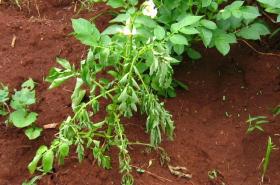
© A.A. Seif, icipe
Budworm (Scrobipalpa blapsigona)
It is reported as one of the major pests of eggplants in Ghana. The small brown caterpillars of the budworm bore into flower buds and feed inside the flowers. This causes the flowers to drop off. Budworm damage is often overlooked, but it can be serious, leading to very low fruit set (Youdeowi, 2002).
- Conserve natural enemies. Caterpillars are usually parasitised by wasps.
- Practise crop rotation.
- Avoid growing eggplant two years in succession.
Cotton leafhoppers or jassids
They are small insects (1-3 mm long), green in colour with slender tapered bodies. Leafhoppers are very mobile. The adults hop away when disturbed. Nymphs resemble adults, but have no wings, and run sideways when disturbed. The eggs are inserted in the leaf tissue on the underside of leaflets. They feed mainly on the underside of eggplant leaves, causing small yellow patches on leaves. Infested leaves curl upwards along the margin. Under heavy attack, leaves turn yellow and then brown and dry, giving a burned appearance. Fruit setting may be very low. Leafhoppers multiply rapidly during dry spells and can cause extensive damage.
- Spray neem products. Commercial and simple (home-made) neem products give control of leafhoppers on eggplants. Thus, an aqueous neem seed extract (10g/l) sprayed at 10 days interval showed repellent effects against leafhoppers (Empoasca) in India. Weekly applications of aqueous neem kernel extracts (6 to 50g/l) and of neem oil (5 to 10 l/ha) controlled the leafhopper, Jacobiasca facialis, in Togo (Osterman and Dreyer, 1995). In Sudan, the commercial products (Neem-Azal-T/S and neem oil-Rimulgan), and home-made neem products (50g/l) controlled leafhoppers on potatoes and eggplants.Control was improved when the neem extract was applied with a pre-pressurised knap sack sprayer instead of a palm leaf brush (El Shafie, 2001).

© Steve L. Brown, University of Georgia, Bugwood.org
Cutworms (Agrotis spp.)
These caterpillars are serious pests particularly in nurseries and of newly transplanted plants. They attack eggplants and many other plants at night. They cut seedlings and usually drag them down into the soil leaving the clean-cut stem. They cannot cut older plants. Large ground beetles, frogs, and birds prey cutworm.
- Plough and harrow the field prior to transplanting. This exposes cutworms to natural enemies and desiccation and helps destroy plant residue that could harbour cutworms.
- Make barriers to protect the transplanted seedlings. Barriers can be made by wrapping paper, aluminium foil, thin cardboard or similar materials around the base of transplant stems. Toilet rolls are handy as cutworm collars since they are readily available and will biodegrade into the soil.
- Dig near damaged seedlings and destroy cutworms.
- Conserve natural enemies. Parasitic wasps and ants are important in natural control of cutworms.
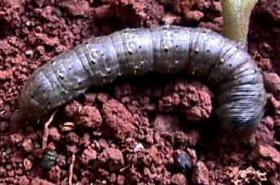
© A.M. Varela, icipe
Early blight or Alternaria leaf and fruit spots (Alternaria spp.)
Several Alternaria spp. are involved. These include A. melongenae, A. solani and A. tenuis. They cause leaf spotting and fruit rots. They produce leaf spots with concentric rings. The spots are mostly irregular, 4 to 8 mm in diameter and may enlarge and cover a large area of the leaf blade. Severely infected leaves drop off prematurely resulting in the reduction of yield. Fruit spots are circular, brown, dry and hard.
- Observe proper field sanitation.
- Use certified disease-free seed.
- Own seed should be water heat treated. For more information on hot water treatment click here
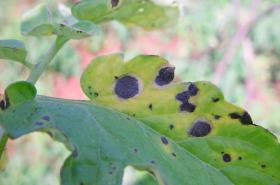
© A.M. Varela, icipe
Eggplant lace bug (Urentius hystricellus)
It is a small bug (about 3 mm in length), brownish in colour. Its body is covered with spines and the wings show a distinct lace-like appearance. Nymphs resemble adults, but are initially wingless, developing wings as they grow. Both adults and nymphs are usually found in groups on the underside of leaves. They suck sap from the leaves causing whitish to yellowish mottled patches on the leaves. In case of serious infestations the leaves turn entirely yellow and drop off. Attacked leaves are speckled with small black shiny spots, which are the faeces of the bugs.
- Spray neem products. They have given effective control of lace bugs on eggplants. The lace bug (Urenthius sp.) was repelled from eggplant plots treated with neem oil (5, 10 and 20%). However, concentrations of 10 and 20% showed phytotoxic effects.
Weekly sprays of an aqueous neem seed extract (50 g/l) and 2% neem oil gave good results against another species of lace bug (Corythaica cyathicollis) attacking eggplant in the Caribbean (Ostermann and Dreyer, 1995).
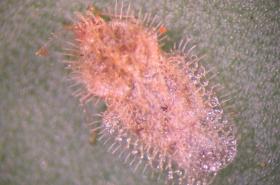
© M. Billah, icipe
Epilachna beetles (Epilachna spp.)
The adult beetle is oval in shape, about 6 mm in length and reddish brown in colour with black spots on their backs. They look very similar to the beneficial ladybird beetles (predators), but the body of this pest ladybird beetle is covered with short, light coloured hairs, which give them a non-glossy or matt appearance. The larvae are pale yellow and covered with branched spines.
They feed on the leaves of eggplants by scraping the surface and eating the leaf tissue between the veins. Attacked leaves may be completely stripped to the mid-veins to skeletons. They may also feed on fruits causing small shallow hollows on the fruit surface. High numbers of these beetles can cause considerable damage.
- Hand pick and destroy adults and larvae. This is feasible in small plots.
- Spray neem products. Neem extracts have repellent effects on these beetles. For instance, sprays with an aqueous neem seed extract (10g/l) at 10 days intervals showed repellent effect on Epilachna beetles in India (Ostermann and Dreyer, 1995).
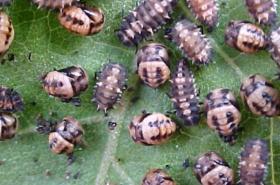
© O.P. Sharma, NCIPM, New Delhi. India, Bugwood.org
Fusarium wilt (Fusarium oxysporum f.sp. melongenae)
Affected plants show yellowing of leaves that progressively wilt and die from bottom upwards. Woody stem and root tissue of diseased plants turn brown. This fungus does not affect tomatoes. Optimum temperature for its growth on eggplants is 27.8° C.
- Use resistant varieties, if available
- Amend soils with organic matter (e.g. compost)
- Practice crop rotation
- In some countries susceptible eggplant varieties are grafted onto resistant rootstocks (e.g. Solanum gilo and S. integrefolium).
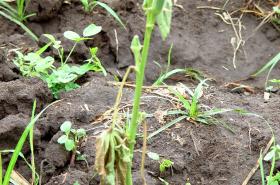
© A.M. Varela & A.A.Seif, icipe
Late blight (Phytophthora infestans)
The late blight fungus affects tomatos, potatoes and eggplants but not pepper. Its symptoms consist of brown spots with purplish tinge and they can develop on leaves, stems, branches and both green and ripe fruits. In moist weather it can cause complete defoliation and rotting of fruits.
- Use resistant varieties, if available
- Practise rotation with non-solanaceous crops (e.g. tomato, potato, peppers etc) for 3 to 4 years. However, this will only be effective if it is done in cooperation with neighbouring farmers since the fungal spores can travel quite large distances by wind.
- In wet weather, copper fungicides, could be applied as soon as the disease is observed or as soon as local experience suggests that the weather conditions are favourable for disease development.
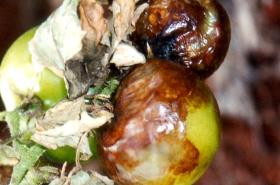
© B. Loehr, icipe
Mole crickets (Brachytrupes spp.)
Mole crickets have been reported as major pests of eggplants in Ghana. They live in the soil, feeding on the roots of many vegetables. They cut seedlings and drag them down into the soil leaving the clean-cut stem.
- Hand pick adults from their burrows.
- Sprinkle wood ash in nursery.
- Plough deep to destroy burrows.
- Expose insects to predators. Large ground beetles, frogs and birds prey on mole crickets.
Phytophthora fruit rot (Phytophthora parasitica)
Phytophthora fruit rot fungus can cause damping-off in seedbeds, leaf spotting and collar rot on the main stem final resulting in plant death. The fungus may attack fruit at any growth stage and any part of the fruit. Spots on the fruit are dark brown, water-soaked and may have a light-coloured border. A whitish mould develops on the spots when wet conditions prevail. The spots are neither sunken nor exhibit concentric rings (zonation). Infected fruits drop prematurely.
The fungus is soil-borne. It is spread in the field by run-off water and farm implements. The disease is favoured by prolonged periods of high moisture and temperatures near 30° C.
- Avoid dense planting.
- Remove and destroy diseased fruit and plants.
- Plough deep because Phytophthora would not survive.
- Practise crop rotation with non-solanaceous crops such as tomato, potato and peppers.
- Where practical, add copper sulphate to irrigation water.
Powdery mildew (Leveillula taurica)
Symptoms appear as yellowish spots on the leaves. On the lower surface of affected leaves the spots are covered by a whitish growth constituting spores of the fungus. Affected leaves eventually dry up but do not fall off. The fungus is endophytic (grows within the leaf contrary to other powdery mildew fungi that are grow on surface of the leaves). It has a wide host range. It is not seed-borne but it survives on herbaceous weeds and other susceptible hosts. Temperatures slightly above 20° C, dry conditions and fairly high relative humidity favour disease infection. However, fungal dispersal takes place mainly at low humidity.
- Use of resistant varieties, if available.
- Use overhead irrigation.
- Use sulphur sprays.
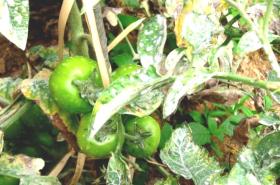
© A. A. Seif, icipe
Root-knot nematodes (Meloidogyne spp.)
Eggplant is highly susceptible to root-knot nematodes, especially on sandy soils. Symptoms of infestation by root-knot nematodes are similar in all crops: wilting of plants and if infested plants are pulled from the soil the roots can be seen to be distorted, swollen and bearing knots. The infested roots eventually rot and affected plants die.
- Use resistant varieties, if available.
- Practise crop rotation.
- Practise mixed cropping. Mixed cropping with African marigold (Tagetes spp.) minimises root-knot nematode damage. Intercrop with different mustards (e.g. Brassica juncea var. integrifolia or Brassica juncea var. juncea) on infested fields. As soon as mustards are flowering they are mulched and incorporated into the soil. While incorporated plant parts are decomposing in a moist soil, nematicidal compounds of this decomposing process do kill nematodes. Two weeks after incorporating plant material into the soil a new crop can be planted or sown (phytotoxic effects are usual if the crop is planted before two weeks).
- Use bioproducts (e.g. neem extracts). For more information on neem click here.
- Use biofumigation where possible.
- Maintain high levels of organic matter in the soil (manure or compost).
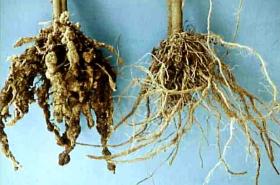
© A. M. Varela, icipe
Shoot and fruit borer (Leucinodes orbonalis)
It is a major pest of eggplant. The adult is a small moth, with a wingspan of 18-24 mm, white in colour with a pink and bluish tinge, and a few brown spots on its wings. Moths lay creamy white single eggs on leaf undersides, stems, flower buds, or the base of fruits. Upon hatching the caterpillars (white in colour) bore into the top section of fruits and tender shoots. Caterpillars develop inside fruits and stems reaching a length of 15-18 mm. When fully-grown, caterpillars make a small hole in the fruit or shoot and drop to the soil and pupate among fallen debris.
When plants start bearing fruits, most caterpillars prefer to feed on the tender fruits. The damage to the shoots is not seen until they droop as a result of the caterpillar feeding inside them. Recently damaged fruits are not easy to detect.
The first indication of damage to the fruit is a small hole just below the calyx where the insect has entered. Fruits are filled with frass. They change colour and taste; they drop off and are unmarketable. Caterpillars are difficult to control with pesticides. Within hours of hatching from eggs, caterpillars enter the shoots or fruits, and are not reached by contact pesticides.
- Conserve natural enemies. Predatory ants are the main natural enemies of the shoot and fruit borer. Other natural enemies include: ladybird beetles, praying mantis, earwigs, predatory bugs and spiders.
- Destroy old eggplant plants and stubble (burn or bury them) immediately after harvest. Pupae can survive in the stubble for several weeks, infesting the new crop.
- Use healthy, pest-free seedlings. Raise seedlings far away from sources of infestation (old eggplant fields, eggplant stubble)
- Grow seedlings under nylon netting to prevent moths from laying eggs on the plants.
- Remove and destroy infested shoots (readily visible as dry tip of branches). Burn, shred into tiny pieces or bury attacked shoots at least 20 cm in the soil. If this is done by all farmers in a community, especially before fruiting, pest infestation and damage can be drastically reduced. Continue cutting attacked shoots at least once a week until the final harvest.
- Destroy infested fruits found during harvest.
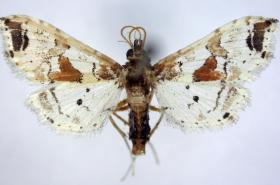
© Koen V.N.Maes
Spider mites (Tetranychus spp.)
Spider mites may become serious pests of eggplant during the dry season. Attacked leaves show a stippled appearance (white specks), and their surface covered with a fine web. Continuous infestation causes the leaves to dry-up. The plants are stunted and yields reduced.
- Conserve natural enemies. Predatory mites and anthocorid bugs are important in natural control of mites.
- Avoid use of broad-spectrum pesticides. They may kill natural enemies and may lead to mite outbreaks.
- Provide good growing conditions for plants. Healthy plants are more likely to withstand mite attack. Adequate irrigation is particularly important. Apply mulch and incorporate organic matter into the soil to improve the water holding capacity and reduce evaporation.
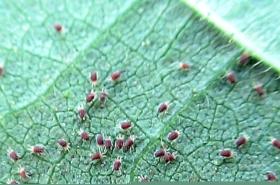
© O.P. Sharma, NCIPM, New Delhi. India, Bugwood.org
Thrips (Thrips spp and Frankliniella spp.)
Thrips are small (1.5 mm long), slender, brown insects with pale yellow hind wings that appear as a yellow line down the back of the body when the insect is at rest. Adult thrips have characteristic wings; the transparent wings have a fringe of hairs around the outside edge standing out in the same plane as the wing.
Thrips attack eggplant mostly during the dry season. They cause browning of leaves, especially on the lower leaf surface. In severe cases, the entire leaf dries. Thrips feeding on fruits causesscarring, irregular discolouration and deformation, which reduce the market value of fruits.
- Monitor the crop regularly for early detection of the pest and signs of infestation.
- Conserve natural enemies. Anthocorid bugs and predatory mites are important natural enemies of thrips. Avoid use of pesticides that kill natural enemies.
- Whenever necessary spray the crop with botanicals or other biopesticides. Some plant extracts (e.g. garlic, rotenone, neem, pyrethrum, and a mixture of garlic and pepper) are reported to control thrips. Spinosad, a bacterial derivative, is effective in controlling thrips.
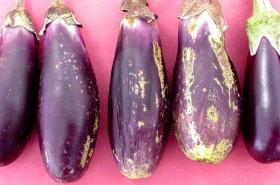
© A.M. Varela, icipe

Thrips

Thrips
Weeds
Eggplant is slow to become established and cannot compete with aggressive weeds. Weeds also harbour insect pests and diseases.
- Remove weeds by hand regularly.
- Cultivate the land. Only shallow cultivation is necessary.
- Mulch plants. Black plastic mulch effectively controls weeds and reduces labour needs. Natural organic mulches such as rice straw help conserving moisture and add organic matter to the soil.
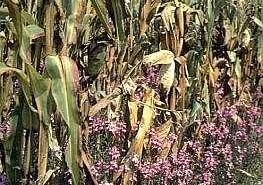
© David C. Nowell, EcoPort
Whiteflies (Bemisia tabaci)
Whiteflies feed on leaves of eggplant sucking plant sap. Whiteflies are vectors of the mosaic virus reported to occasionally affect eggplant in West Africa.
- Apply neem products. Neem products have given control of the tobacco whitefly on eggplant. In the Caribbean, weekly sprays of neem seed powder (50g/l), and 2% neem oil gave good protection against this pest (Ostermann and Dreyer, 1995).
In Sudan, commercial neem products and home-made products (neem seed water extract 50g/l) reduced the populations of Bemisia tabaci on eggplant and potato (El Shafie, 2001).
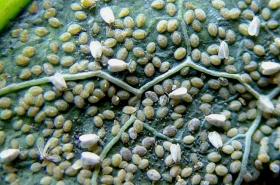
© A. M. Varela, icipe
| General Information and Agronomic Aspects | Information on Pests | |||
| Fresh Quality Specifications for the Market in Kenya | Information Source Links | |||
| Information on Diseases | Contact Information |
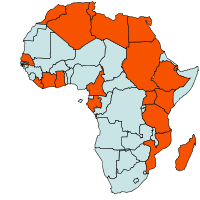 |
| Geographical Distribution of Eggplant in Africa |
Nutritive Value per 100 g of edible Portion
| Raw or Cooked Eggplant | Food Energy (Calories / %Daily Value*) |
Carbohydrates (g / %DV) |
Fat (g / %DV) |
Protein (g / %DV) |
Calcium (g / %DV) |
Phosphorus (mg / %DV) |
Iron (mg / %DV) |
Potassium (mg / %DV) |
Vitamin A (I.U) |
Vitamin C (I.U) |
Vitamin B 6 (I.U) |
Vitamin B 12 (I.U) |
Thiamine (mg / %DV) |
Riboflavin (mg / %DV) |
Ash (g / %DV) |
| Eggplant cooked | 35.0 / 2% | 8.7 / 3% | 0.2 / 0% | 0.8 / 2% | 6.0 / 1% | 15.0 / 1% | 0.3 / 1% | 123 / 4% | 37.0 IU / 1% | 1.3 / 2% | 0.1 / 4% | 0.0 / 0% | 0.1 / 5% | 0.0 / 1% | 0.5 |
Nursery preparation. The seeds are sown in a well-prepared raised seedbed with friable soil (soil that breaks or crumbles easily when handled) in rows 10 cm apart. Space the seeds well to make transplanting easier. Before sowing an application of 3 to 5 kg of good compost per m² is incorporated into the nursery seedbed.
In tropical areas, seeds are sown in a shaded seedbed and watered regularly. The seedlings emerge after 8-10 days. Before planting, fertilise the field with compost or farmyard manure.
The ideal transplant is a seedling with three to four true leaves, stocky and disease-free, and without flower buds. Begin hardening plants 6 to 9 days before transplanting to reduce transplanting shock. Slightly withhold water. Thoroughly water seedlings 12 to14 hours before transplanting to the field. Transplanting should be done in the late afternoon or on a cloudy day in order to minimise transplanting shock. Before transplanting, place a basal dose of 15 to 30 tons/ha compost or well-rotted farmyard manure in the planting furrows or planting holes and mixed with the soil.
Transplant seedlings by digging a hole deep enough to bury a plant so that its first true leaf is just above the soil surface. Press the soil firmly around the root. Irrigate furrows immediately after transplanting.
Watering newly transplanted plants well with compost tea or EM (effective microorganisms) will give the seedlings a good start. To prepare your own compost tea, mix 1 part of compost with 6 parts of water. Leave the mixture for one week. Strain and spray on seedlings to control fungal pathogens and prevent infection.
- "Black Beauty" It takes about 100 days from transplanting to harvest. The fruit is oval to heart shaped glossy purple to almost black. Fruit size is about 10 x 8 cm. It has a good shelf life. It is unsuitable in cold wet areas.
- "Florida High Bush" From transplanting to harvest is about 100 days. Fruit shape is elongate oval. Fruit size is about 15 x 8 cm. It is unsuitable for cold wet areas.
- "Ravaya" It is an early maturing (about 80 days), high yielding variety. The fruits are slender, purple-coloured and borne in bunches of 3-4. This variety is popular for fresh export market.
- "Long Purple". It is ready for harvest about 70-80 days after transplanting. Fruit shape is cylindrical. Fruit size is about 11 x 5 cm. It is unsuitable for cold wet areas.
- "Early Long Purple". From transplanting to harvest is 90 days. Fruit shape is long cylindrical. Fruit size is about 12 x 6 cm. It is unsuitable to cold wet areas.
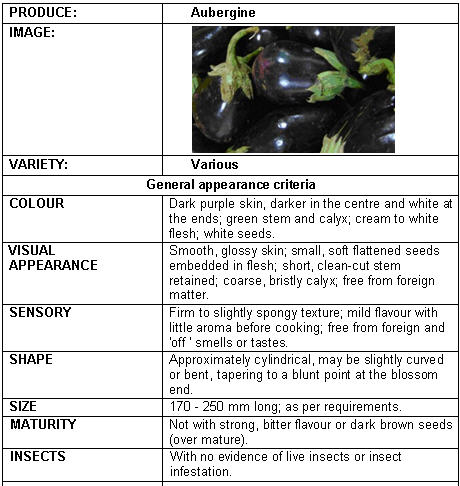 |
| © S. Kahumbu, Kenya |
|
Early blight or Alternaria leaf and fruit spots (Alternaria spp.) Several Alternaria spp. are involved. These include A. melongenae, A. solani and A. tenuis. They cause leaf spotting and fruit rots. They produce leaf spots with concentric rings. The spots are mostly irregular, 4 to 8 mm in diameter and may enlarge and cover a large area of the leaf blade. Severely infected leaves drop off prematurely resulting in the reduction of yield. Fruit spots are circular, brown, dry and hard. | 
Early blight
Early blight (here on tomato leaf). Leaf spots of early blight are circular, up to 1 cm in diameter, brown, and often show a circular pattern, which distinguishes this disease from other leaf spots on tomato. © A.M. Varela, icipe |
|
What to do:
|
|
Root-knot nematodes (Meloidogyne spp.) Eggplant is highly susceptible to root-knot nematodes, especially on sandy soils. Symptoms of infestation by root-knot nematodes are similar in all crops: wilting of plants and if infested plants are pulled from the soil the roots can be seen to be distorted, swollen and bearing knots. The infested roots eventually rot and affected plants die. | 
Root-knot nematodes
Root-knot nematodes (Meloidogyne incognita / M. javanica) Roots of severely attacked (left) and healthy plant (right). Affected plants are normally stunted and eventually wilt and die. The most characteristic symptom is formation of root galls (knots) and these can be seen with the naked eye. Affected roots rot. © A. M. Varela, icipe |
|
What to do:
|
- AIC, Nairobi, Kenya (2000). Local and Export Vegetables Growing Manual.
- AVRDC, the World Vegetable Center (2003). Harmful and helpful insects in eggplant fields. www.avrdc.org
- AVRDC, the World Vegetable Center. (2003). How to control eggplant fruit and shoot borer. www.avrdc.org
- Beije, C.M., Kanyangia, S.T., Muriuki, S.J.N.,Otieno, E.A., Seif, A.A., Whittle, A.M.(1984). Horticultural Crops Protection Handbook. National Horticultural Research Station, Thika KEN/75/028 and KEN/80/017
- Bohlen, E. (1973). Crop pests in Tanzania and their control. Federal Agency for Economic Cooperation (bfe). Verlag Paul Parey. ISBN: 3-489-64826-9
- CAB International (2005). Crop Protection Compendium, 2005 Edition. Wallingford, UK www.cabi.org
- Chen, N.C., Kalb, T., Talekar, N.S., Wang, J.F., Ma, C.H. (2002). AVRDC Training Guide: Suggested Cultural Practices for Eggplant. www.avrdc.org
- Critchley, B. R. (1995). Manual for the Integrated Pest Management of diseases, insects, nematodes and weeds of garden egg, okra, onion, peppers, and tomato in Brong Ahafo, Ghana. Natural Resources Institute (NRI). UK
- East African Seed Co. Ltd. Africa's Best Grower's Guide www.easeed.com
- El Shafie, H. A. F. (2001). The use of neem products for sustainable management of homopterous key pests on potatoes and eggplants in the Sudan. PhD thesis. Institute of Phytopathology and Applied Zoology. Justus Liebig University of Giessen.
- Lost Crops of Africa: Volume II: Vegetables (2006). Development, Security, and Cooperation (DSC). Online read-only: The National Academy Press: www.nap.edu
- Nutrition Data www.nutritiondata.com.
- Ostermann, H., Dreyer, M. (1995). Vegetables and grain legumes. In: The Neem tree Azadirachta indica A. Juss. and other meliaceous plants sources of unique natural products for integrated pest management, industry and other purposes. Edited by H. Schmutterer in collaboration with K. R. S. Ascher, M. B. Isman, M. Jacobson, C. M. Ketkar, W. Kraus, H. Rembolt, and R.C. Saxena. VCH. pp. 392-403. ISBN: 3-527-30054-6
- Youdeowei, A. (2002). Integrated pest management practices for the production of vegetables. GTZ. Integrated Pest Management Extension Guide 4. Published by The Ministry of Food and Agriculture (MOFA) Plant Protection and Regulatory Services Directorate (PPRSD), Ghana with the German Development Cooperation (GTZ). ISBN: 9988-0-1088-5.
- Amiran Kenya Ltd. seeds@amirankenya.com
- Corner Shop, Nairobi. cls@mitsuminet.com
- East African Seed Company Ltd. www.easeed.com
- Food Network East Africa Ltd. info@organic.co.ke +2540721 100 001
- Green Dreams. admin@organic.co.ke +254721 100 001
- HCDA. md@hcda.or.ke www.hcda.or.ke +2542088469
- Kalimoni Greens. kalimonigreens@gmail,com +254722 509 829
- Karen Provision Stores, Nairobi. karenstoresltd@yahoo.com +25420885552
- Muthaiga Green Grocers, Nairobi
- Nakumatt Supermarket info@nakumatt.net 020551809
- National Horticultural Research Centre, KARI, Thika. karithika@gmail.com. +2546721281
- Simlaw Seeds Co. Ltd. simlaw@kenyaweb.com
- Uchumi Supermarket info@uchumi.com +25420550368
- Zuchinni Green Grocers, Nairobi +254204448240

 Back
Back
